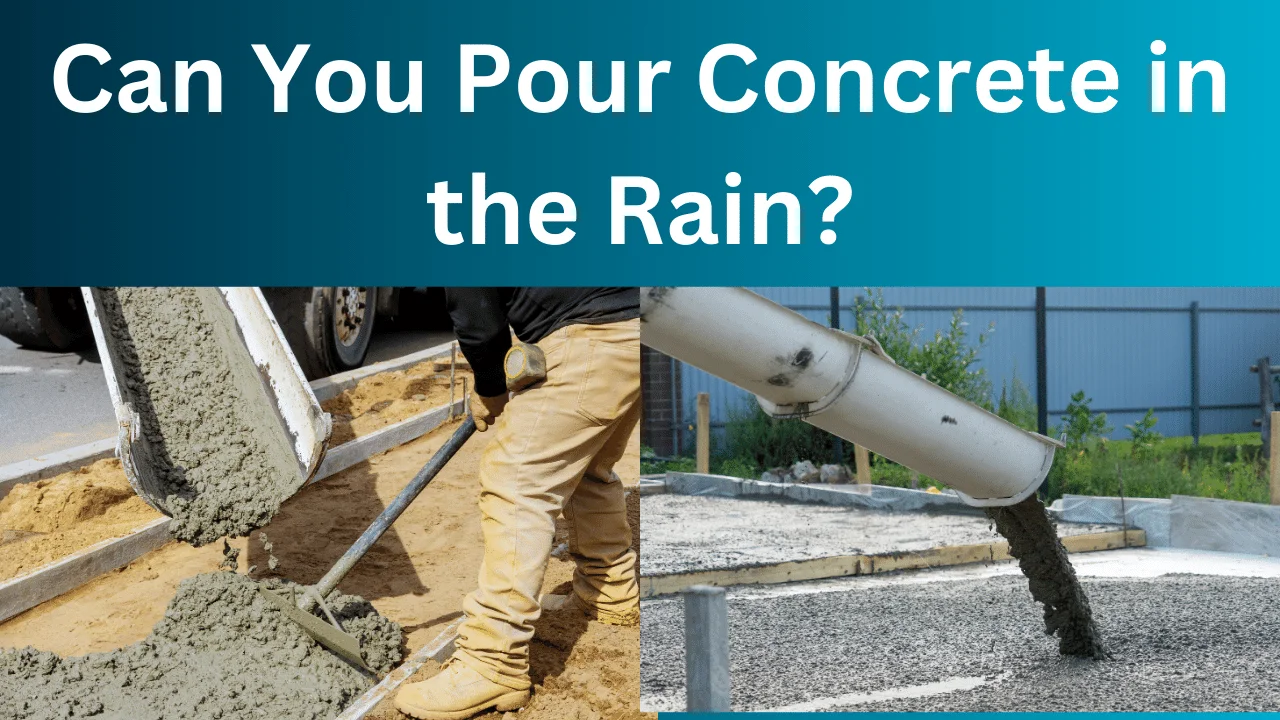Pouring concrete under ideal circumstances guarantees maximum strength and longevity; hence, it is an essential building process. While pouring and curing, rain can cause a number of problems. It is feasible to pour concrete in wet conditions while ensuring its integrity if the right measures and procedures are followed. Expert tips and in-depth analysis are provided in this article that delves into the many facets of pouring concrete in wet weather.
To lay a solid groundwork for buildings, roads, and other structures, concrete pouring is a common but crucial aspect of many building projects. When the weather is nice, mixing, pouring, and curing concrete are usually not complicated processes. When it starts to rain, though, things get trickier, and people start to wonder whether it’s safe and practical to pour concrete in the rain.
Understanding the Impact of Rain on Concrete
Effects of Rain on Fresh Concrete
Fresh concrete is especially vulnerable to the effects of rainwater, which can weaken and eventually dissolve the material. The main issues revolve around watering down the concrete mixture, raising the water-to-cement ratio, and the possibility of surface flaws. When pouring concrete in wet weather, it is essential to know these effects.
Dilution of Concrete Mix
A higher water-to-cement ratio may result when rainwater is mixed with newly mixed concrete because it dilutes the mixture. The concrete’s overall strength and durability may be diminished as a result of this diluting. When pouring concrete, it is crucial to keep as little rainwater as possible in contact with the mixture.
Increased Water-to-Cement Ratio
Concrete with a higher water-to-cement ratio has the potential to be less dense and more porous. Reduced compressive strength, increased permeability, cracking, and surface defects are some of the issues that can result from this. Keeping the concrete mix’s water content under control is critical to preserving its quality.
Surface Defects
Surface flaws in newly mixed concrete, such as dusting, scaling, and cracking, can be brought about by precipitation. Surface powderiness is the hallmark of dusting, whereas flaking or peeling is characteristic of scaling. Excess water makes drying and curing uneven, which can lead to cracking. Damage to the concrete’s structural integrity and visual appeal can result from these flaws.
Preparing for a Rainy Pour
Planning and Monitoring Weather Conditions
When pouring concrete in wet weather, one must carefully plan and keep an eye on the forecast. One way to lessen the impact of rain is to stay vigilant about weather predictions and be ready for any unexpected changes.
Monitoring Weather Forecasts
If you keep an eye on the weather, you can schedule your concrete pour for when it’s likely to rain. Postponing the pour until weather conditions improve is usually the best course of action when heavy rain is expected. But if it’s just a little rain or comes and goes, you can probably get away with it.
Preparing the Site
Site preparation includes safeguarding the area where concrete will be poured and making sure there is adequate drainage. To avoid water getting on the concrete, it is necessary to install waterproof coverings and barriers.
Using Waterproof Covers
To protect the freshly poured concrete from rain, cover the area with waterproof tarps or plastic sheets. Tightly fastening these covers will make them windproof and watertight.
Ensuring Proper Drainage
Water must not collect on or beneath the concrete, thus adequate site drainage is of the utmost importance. Making channels or trenches to divert water away from the pour area is one way to lessen the likelihood of water seepage.
Adjusting the Concrete Mix
Lower Water-to-Cement Ratio
Concrete can be made more resistant to rain damage by using a lower water-to-cement ratio. To do this, you must experiment with different proportions of the mixture until you find the sweet spot between workability and strength.
Incorporating Waterproofing Admixtures
To make concrete more resistant to water damage and infiltration, waterproofing admixtures can be added to the mixture. These additives make the concrete stronger and more resistant to cracking, making it ideal for use in rainy weather.
Using Accelerators
Concrete curing time can be reduced with the use of accelerators, which are admixtures. The use of accelerators shortens the setting time of concrete, making it more resistant to damage caused by rain in the hours after pouring.
Pouring and Protecting Concrete
Pouring Techniques in the Rain
To keep the mixture intact and the surface protected while pouring concrete in wet weather, certain procedures are required. This entails managing surface water and adjusting the pour rate.
Controlling the Pour Rate
It is easier to keep the concrete from becoming too wet if the pouring rate is controlled. To accomplish this, pour the concrete in smaller portions and cover and protect each one before moving on to the next.
Managing Water on the Surface
If any water collects on top of the newly poured concrete, use a float to gently pour it off. Because it might weaken the top layer and cause surface flaws, you should not work the water into the mixture.
Covering Freshly Poured Concrete
It is critical to cover newly poured concrete immediately in order to prevent it from being wet. Make sure to completely cover and secure the concrete with waterproof tarps or plastic sheets to avoid water infiltration.
Securing the Covers
If you want to keep rain and wind from blowing away your covers, you should fasten them securely. To achieve this, you might need to secure the covers in place with tie-downs or weights.
Post-Pour Considerations
Initial Curing Period
The concrete’s strength and durability are developed during the initial curing period. The concrete needs to be kept dry for this duration, which usually ranges from four to eight hours.
Protecting During Initial Curing
Keep the concrete covered and out of the rain while it cures for the first time. If water from rain gets on the surface, wipe it off carefully so as not to damage the concrete.
Long-Term Curing and Protection
Proper curing of the concrete for a further 28 days is required for it to reach full strength after the initial curing period. The concrete should still be protected and monitored as needed, but light rain during this period is less likely to cause significant issues.
Ensuring Proper Curing
Keeping the concrete at the correct moisture level is essential for proper curing. Curing compounds, covers, or continuous watering can accomplish this, but it all depends on the project’s unique conditions and needs.
Addressing Surface Defects
You should fix surface flaws like dusting, scaling, or cracking as soon as you notice them. In order to get the concrete looking and feeling like new again, it may be necessary to use repair compounds or resurfacing techniques.
Best Practices for Pouring Concrete in the Rain
If you want your concrete to stay strong and long-lasting even after it rains, there are certain things you should do. From getting ready to doing things after the pour, these practices cover it all. Important guidelines for controlling concrete pours in rainy weather are as follows.
Preparing the Worksite
Site Inspection and Preparation
Thoroughly inspect and prepare the worksite before beginning any concrete pour, especially if it’s going to rain. Make sure there is no standing water and that the ground is solid. Build drainage channels to redirect water away from the pour site if needed.
Setting Up Barriers and Covers
Protecting the concrete from direct rainfall requires the installation of physical barriers and covers around the pour site. Make use of robust materials such as plastic sheeting or waterproof tarps. To keep these covers from slipping off in strong winds, anchor them with weights or tie-downs.
Storing Materials Properly
Keep all materials, such as aggregates, sand, and cement, in a dry, covered location. These materials’ quality can be negatively impacted by moisture, which in turn affects the final concrete mix. To keep them intact, use containers and covers that are waterproof.
Adjusting the Concrete Mix for Rainy Weather
Lowering the Water-to-Cement Ratio
You can lessen the likelihood of water diluting your concrete mix when it’s raining by reducing the water-to-cement ratio. This modification ensures that the mix’s strength and durability are preserved, even when rainwater is added.
Using Waterproofing Admixtures
The concrete’s resistance to water damage can be increased by adding waterproofing admixtures to the mix. With the help of these additives, concrete becomes more water-resistant and less porous, making it ideal for use in damp environments.
Adding Accelerators
Accelerators can be used to shorten the curing time and reduce the exposed area to rain. Concrete can be subjected to moisture sooner and hardened more rapidly with the help of these admixtures, which reduce the setting time.
Techniques During the Pour
Pouring in Sections
If you must pour concrete while it is raining, divide the job into smaller portions. You can better manage and protect each section using this approach, which lowers the risk of water damage and infiltration.
Using Float Techniques
Float the rainwater gently off the surface of newly poured concrete if it collects. This method is useful because it keeps the rain from penetrating the concrete and weakening the top layer, which can cause surface flaws.
Immediate Covering
Snap plastic sheets or waterproof tarps over each area of poured concrete as soon as possible. Covers should be fastened so that rainwater does not come into touch with newly-poured concrete.
Post-Pour Protection and Curing
Maintaining Covers
Make sure the covers are still in place after pouring and covering the concrete by checking and maintaining them on a regular basis. In order to maintain the covers’ effectiveness and security, it may be necessary to adjust the weights or tie-downs.
Controlling Moisture Levels
Ensuring the concrete’s moisture levels are controlled is essential for proper curing. Curing compounds or constant moisture applied to the concrete surface under the covers can achieve this. For concrete to reach its maximum strength and durability potential, it is essential to keep the moisture level just right.
Monitoring for Surface Defects
Keep an eye out for surface flaws like dusting, scaling, or cracking in the curing concrete. Preventing long-term damage and ensuring a smooth, durable finish can be achieved by addressing these issues early on.
Evaluation of Long-Term Sturdiness
Using Sealants
After concrete has cured, it can be sealed to make it more resistant to water and weather. By adding an extra barrier, sealants lessen the likelihood of surface wear and water penetration.
Regular Maintenance
For long-term durability, it is essential to regularly maintain concrete surfaces that are exposed to the elements. This entails checking in on a regular basis, cleaning up afterward, and fixing things up when they break.
Enhanced Drainage Solutions
To stop water from collecting and seeping into concrete buildings, use improved drainage systems. The probability of water damage and the concrete’s lifespan are both decreased with good drainage.
Protecting Concrete in Extreme Weather
Dealing with Heavy Rainfall
Concrete pouring and curing are already complicated processes, and heavy rains just make things worse. If you can, try to delay the pour in these kinds of situations. Additional safety measures, like double-layered covers and improved drainage systems, will be required if the pour must go ahead.
Winter Rain and Cold Temperatures
Particular dangers arise from mixing wet weather with cold temperatures when pouring concrete in the winter. Warm water in the mix, insulation of the pour site, and cold-weather admixtures are some special measures that can help reduce these risks.
Handling Unexpected Storms
No matter how meticulously you track the weather, unexpected storms can still happen. To keep the concrete dry in the event of an unexpected downpour, it is wise to have backup plans in place, such as easily deployable covers and extra personnel to oversee the site.
Concrete Surface Treatments
Applying Surface Hardeners
To make newly mixed concrete more durable and resistant to wear and water damage, surface hardeners are applied. Locations that experience heavy rainfall and prolonged exposure to moisture would benefit greatly from these treatments.
Using Decorative Overlays
In addition to improving the look of concrete surfaces, decorative overlays also add a protective layer. The durability of the concrete can be enhanced by designing these overlays to be more resistant to rain and other weather effects.
Implementing Anti-Slip Coatings
Coatings that prevent slips and falls can increase the longevity and security of concrete surfaces that are constantly wet and walked on. The concrete is protected from water-induced wear and these coatings aid in accident prevention.
FAQs
Is It Safe to Pour Concrete in the Rain?
Pouring concrete in the rain is generally discouraged due to potential issues with the concrete’s integrity and appearance. However, with the right precautions, it is possible to manage the risks and ensure a durable finish.
How to Protect Concrete from Rain During Pouring?
Protecting concrete from rain during pouring involves using waterproof covers, ensuring proper drainage, adjusting the concrete mix, and using accelerators. These measures help minimize the impact of rain and maintain the quality of the concrete.
What Happens if It Rains After Pouring Concrete?
If it rains after pouring concrete, the main concern is the potential for surface defects and weakened structure. Properly covering and protecting the concrete immediately after pouring can mitigate these risks and ensure a successful cure.
Can You Pour Concrete in Light Rain?
Pouring concrete in light rain is possible with appropriate precautions. This includes monitoring weather conditions, using waterproof covers, adjusting the concrete mix, and ensuring proper drainage around the site.
How to Fix Concrete Damaged by Rain?
Fixing concrete damaged by rain involves addressing surface defects such as dusting, scaling, or cracking. This may include using repair compounds, resurfacing techniques, or other methods to restore the concrete’s appearance and structural integrity.
Also Read: Can I Use Grout as Mortar?
Conclusion
Although there are a number of obstacles to overcome, it is possible to successfully pour concrete in the rain with proper preparation and the use of appropriate techniques. You can make sure the concrete lasts and looks good by learning how it will react to rain, getting the site ready, tweaking the mixture, and covering the newly poured concrete. To make sure your building projects last as long as possible and your concrete stays dry, you should always keep an eye on the weather and be ready to act quickly if necessary.

Shannon Reyes is a seasoned writer with a knack for crafting engaging blogs on a variety of service industries, including plumbing, cleansing, moving, pest control, and roofing. With a keen eye for detail and a passion for helping readers navigate complex topics, Shannon brings her expertise to life through informative and accessible content.










